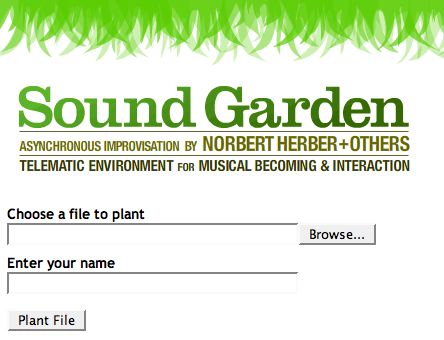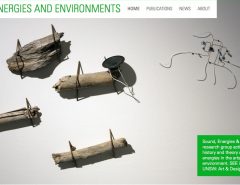Sound Garden
Asynchronous Improvisation by Norbert Herber + Others
Telematic environment for MUSICAL BECOMING & INTERACTION
Sound Garden is the second work in a series of musical installations that explore the relationship of people, location, and audio relative to technology. In this context, people include those who use, visit, listen to, and tend the garden. Location means both physical and virtual spaces, and audio refers to manifestations of sound, silence, noise, and music. The technology explored in this project specifically includes interactive, telematic systems, digital signal processing (for audio), quadraphonic amplification, environmental sensors, and artificial life (A-Life) systems.
http://www.x-tet.com/soundgarden/
How Sound Garden works
Sound material is to be provided by all who visit, whether online or at the actual site. Help cultivate the garden with your own short recordings, samples, soundscapes, and found sonic objects.
Use the Browse button in the web interface to «plant» MP3 files you would like to hear, or «prune» the garden and uproot files with the Remove button. Sound files must be fixed bit-rate MP3s. No WAV or AIFF, no VBR MP3, and no AAC or .m4a from iTunes.
Sound Garden is a continuous work, meaning it is not defined by a performance of any particular duration. Listeners may situate themselves in the garden and remain indefinitely. The music is characterized by sonic events that are unique in the moment—a personal and poetic sensation of sound, where listeners construct an individual musical experience as the focus of their listening shifts over time.
In the tradition of the physical work associated with organic gardens (planting, watering, fertilizing, weeding, pruning, etc.) Sound Garden provides an online interface that allows listeners to tend their sonic environment and take an active role in its composition and care. Using a web browser to select from a menu, listeners can contribute their own digital audio files (musical material, voice and environmental recordings, etc.) and become gardeners that help to form the overall sonic landscape of Sound Garden.
Because each sound is unique, the «seeds» that are planted will significantly affect the primary characteristics of the garden. A generative musical system uses Particle Swarm Optimization (Kennedy & Eberhart, 1995) to grow these seeds and define the overall structure. But Sound Garden is also largely shaped by events that occur at the site of installation. Environmental sensors tracking ambient light levels, temperature, motion, and vibration act on individual sounds that compose the garden. These sensors serve as additional layers in the musical system, and control a variety of signal processing parameters. As environmental conditions shift and change, the sensors reflect that change in the garden’s constant growth and development.
My musical works are primarily concerned with the idea of becoming. In Creative Evolution, Henri Bergson writes about becoming and our perception of reality, «Matter or mind, reality has appeared to us as a perpetual becoming. It makes itself or it unmakes itself, but it is never something made.» I seek this same quality, and work to compose music within interactive systems that leads to a becoming of sound—music that is making, unmaking, but never made.
(…)





Leave a Reply
Lo siento, debes estar conectado para publicar un comentario.